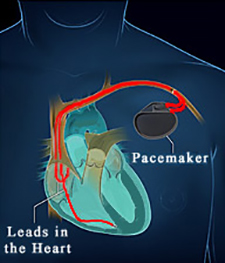
A pacemaker is a medical device that delivers electricity to the heart via small electrodes, triggering the heart to beat.
A normal human heart contains an intrinsic pacemaker, termed the sinoatrial (SA) node. This group of cells within the heart generates an electrical impulse usually 60 to 100 times per minute that stimulates the heart muscle to contract. In certain illnesses, or with age, these cells may become diseased or unable to perform their duty on a consistent basis. This results in bradycardia (or slow heart beats) which can be treated with the placement of an artificial pacemaker (see image on the right).
Understanding the Pacemaker Placement Procedure
 Following patient sedation, a small incision (approximately 2-3 inches) is made beneath the collar bone. Electrodes (termed "leads") are then inserted into the subclavian vein and passed inside this vein to the heart (see image on the right). Electrodes have small screw-like coils on their tips that enable them to be secured into place within the heart muscle. The electrodes are then attached to the pacemaker generator which is placed underneath the skin. The skin surface is closed with sutures.
Following patient sedation, a small incision (approximately 2-3 inches) is made beneath the collar bone. Electrodes (termed "leads") are then inserted into the subclavian vein and passed inside this vein to the heart (see image on the right). Electrodes have small screw-like coils on their tips that enable them to be secured into place within the heart muscle. The electrodes are then attached to the pacemaker generator which is placed underneath the skin. The skin surface is closed with sutures.
Following implantation, pacemaker function is closely monitored on follow-up visits. During device checks, which may be performed in the physician's office or even at home with telephonic monitoring, detailed information about both the pacemaker (e.g. battery life or frequency of pacing) and the intrinsic heart (e.g. underlying rhythm) is able to be obtained and helps with ongoing management.



